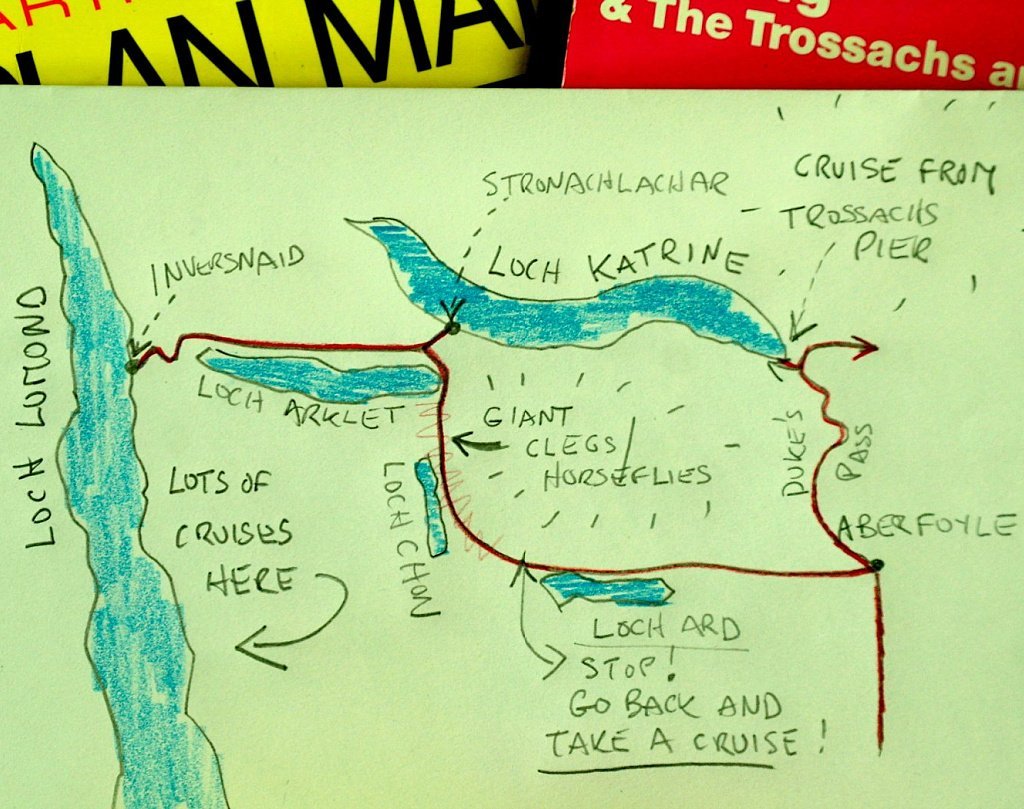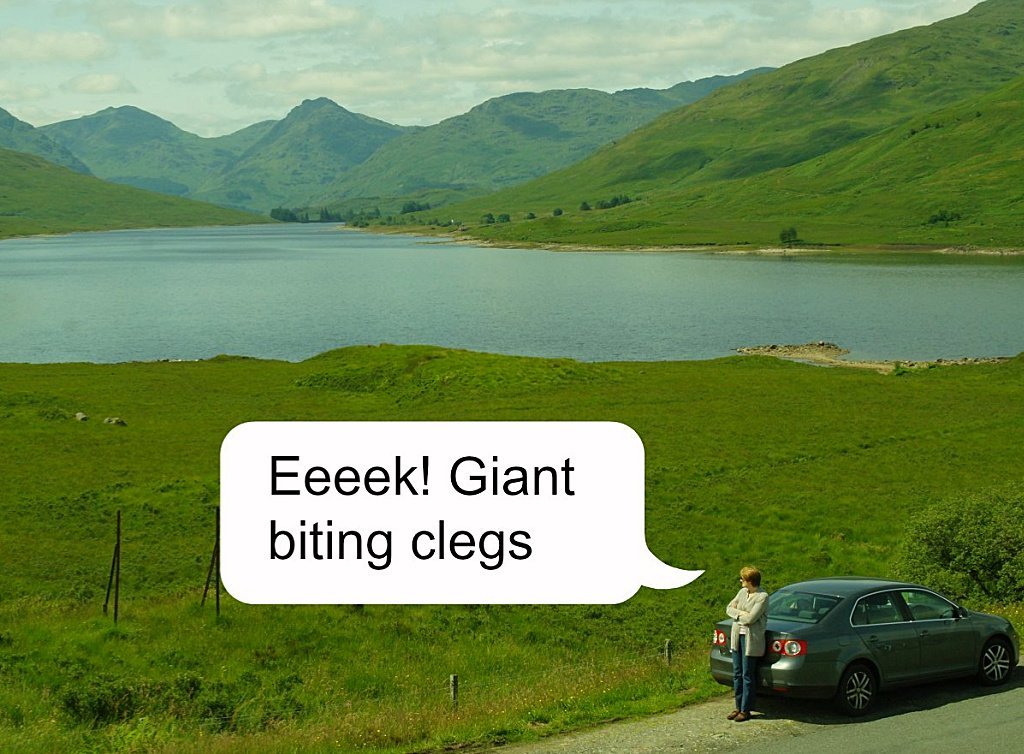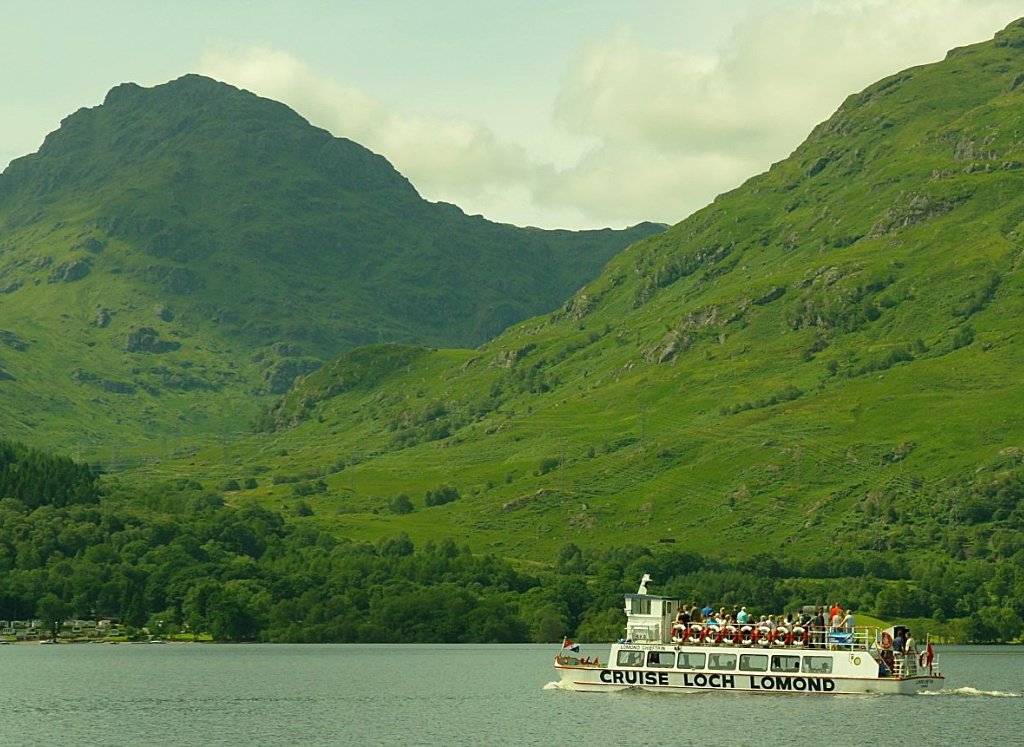Best way to see the Loch Lomond area? Go cruising Loch Lomond. Especially in summer to avoid the biting clegs and midges. Seriously – avoid driving the Aberfoyle-Stronachlachar-Inversnaid at peak times. We’ll tell you why.
Cruising Loch Lomond and Loch Katrine, too
This is some advice on cruising Loch Lomond and also cruising Loch Katrine in the heart of The Trossachs. It’s based on a summer excursion from Aberfoyle, the southern gateway to The Trossachs.
This was a driving day, not even a day when we actually went on Loch Lomond for a cruise (but wish we had…)
Aberfoyle is the southern gateway to the Trossachs, where tourism began in Scotland more than two centuries ago.
Today, the road west from Aberfoyle is lined by the solid old houses of earlier days – many of them now small hotels and guest houses.
Houses that have seen, year after year, the processions of tourists ready for their boat trip on Loch Lomond and taking the road that leads to the stonemason’s point on Loch Katrine and further on to the mouth of the needle burn (stream) on Loch Lomond.
What? Where? Oh, that’s how Stronachlachar and Inversnaid respectively are translated from their original Gaelic – a language spoken exclusively here when William and Dorothy Wordsworth passed through in 1803.
Look, tell you what, I’ll draw you a map. I know you could look it up on Google Maps but where’s the fun in that?

Wait! Escape the biting beasties by taking to the waters of Loch Lomond. Book right here below…A cruise with Sweeney’s Cruise Co for example starts from as little as £14!!!

Pictured here) A warm high-season day on the road to Inversnaid on the banks of Loch Lomond. Here’s an interesting thing for those of a geological disposition. There is no Loch Lomond in the picture.
Why? Because it lies between the far end of Loch Arklet, which is pictured here, and the mountains on the skyline. It lies in a deep glacial trough at right angles to the loch here, so that Loch Arklet is, in effect, the upper part of a ‘hanging valley’.
The waterfall pictured further down the page is an outlet of Arklet, tumbling down to the much lower Loch Lomond.
Now, instead of driving from Aberfoyle to Inversnaid on Loch Lomond, as we did, if you are thinking of taking to the water on Loch Lomond, you will probably do the research and find out that cruising is just one of the many outdoor options available in the area.
Many of these involve Lycra or Goretex and are all the more laudable because of that. It’s a playground – an easily accessible bit of Highland Scotland – and has been that way since the first tourists arrived before the end of the 18th century.
The Road West – Aberfoyle To Stronachlachar And Inversnaid.
Anyway, instead of an excursion on Loch Lomond, we set off, driving west from Aberfoyle and, sure enough, in the sunshine on that narrow west-bound road, we encountered cyclists.
They were either wobbling uncertainly on the crest of a blind uphill bend, or in family-packs, strung out along the rolling highway.
And it was great to see the determination, and sometimes even enjoyment, in their faces as they gritted their teeth and put their face to the brae.
It’s a road made for cycling. Not driving, as we were soon reminded.
Treacherous verges, cyclists in ambush
Beyond Loch Ard – “wait, wait, there’s a super shot of picturesquely decaying boat houses and Ben Lomond; oh, shoot, no parking places” – the woods close in.
The verges are treacherous – we grounded badly while giving way to a family car, full of children, that came barrelling towards us out of nowhere.
(Don’t these people know how to drive on narrow Highland roads?)
More wobbly cyclists lay in ambush. After Loch Ard, the cloying, view-less lush summer greenness ruled for a few miles, with a glimpse of Loch Chon.
Then the landscape opened out and we shot past the best parking spot for that view – oh that aching, nostalgia-provoking view of the mountains of the west – see above. Nice, isn’t it?
Clegs! The Silent Scourge…
We stopped in the next available place; I grabbed the camera, jumped the little ditch, and trampled on some bog myrtle that released the scent that is the essence of the West Highlands.
I climbed a little knoll, disturbing insects, bigger than midges. I crouched down to get some bog asphodel in the foreground of the pic.
These insects were brown, silent and determined. Oh-oh, it was the silent scourge – clegs – horseflies. A pin-prick on my wrist as I framed the shot. Brushed it away and it returned to exactly the same spot.
I retreated to the car. Now, if any of you have read the day on Ladhar Bheinn on this website (and you know you should) or if you personally know Johanna, then you will be aware of her irrational fear of these insects.
Scottish clegs fly with a kind of sleekit skill on their approach: homing in on elbows, the backs of the legs, or any extremity of bare skin.
(Sleekit is a Scots word that what we use for crafty or underhand, definitely in a bad way. Sometimes used of politicians, but definitely not often enough these days.)
Do clegs bite through clothing?
And one of my best chums who read this page insisted that clegs also bite through clothing and don’t just land on bare skin. Could it get any worse?
Anyway, I found Johanna cowering in the car, pointing through the windscreen, through which, I swear, a cleg was leering and grimacing at her. We drove on.
The road is ‘T’ shaped, as you can see by my little drawing above (almost as good as ‘street-view’ wouldn’t you say?). Stronachlachar is at one end of the top part, on Loch Katrine, and Inversnaid at the other, down by the shores of Loch Lomond, on the left.

The car park at Stronachlachar was quite full. The tearoom was busy. No vessels were in sight. The daily April to October cruising on Loch Katrine starts from the main Trossachs pier, at the other end of the loch.
We took the statutory photos, looking east down the loch. There was Factor’s Island, where Rob Roy held captive the Duke of Montrose’s factor.
There was Royal Cottage, in the distance, where in 1859 Queen Vicky opened the aqueduct that brought clean water to Glasgow.
We sat on a bench in the sunshine. A brown insect landed on my shirt. I pointed at it, whereupon Johanna fled to the car. Yes, the clegs meant business.

Onwards To The Bonnie Banks…
We started west again. Little Loch Arklet is an ugly loch, with one of these shoreline scars that result from the varying water levels – it artificially feeds into Loch Katrine and is dammed at its west end.
On the other hand, past the site of the old former garrison built by the Duke of Montrose to curtail the activities of his adversary Rob Roy, the descent to Loch Lomond with the Needle Burn on the left is very attractive.
Down by the bonnie banks, the road ends in a large car park, overlooked by the sprawling Inversnaid Hotel.
I was even able to extract Johanna from the car, with promises that the loch-side breeze (which I invented on the spur of the moment) would keep both clegs and midges away.

The sun poured down. (Like honey, if you are a Leonard Cohen fan.) Groups of walkers appeared from time to time, north- and south-bound on the West Highland Way that runs amongst the oak woods along the shore at this point.
The waterfall that drops out of the hanging valley that holds Loch Arklet, above us, was roaring with a drifting spray cloud that was refreshing on the skin.
The view, pictured here, maybe left or somewhere near where you’re reading – I don’t know any more – is over Loch Lomond from a bridge above the waterfall.
After a visit here the poet Gerard Manley Hopkins wrote his poem ‘Inversnaid’.
A cruise-boat nosed in towards the pier. There, sturdy rucksack-laden walkers waited, next to chirping families, ready to climb aboard. It was a snapshot of summer on the loch.
And that was when it occurred to me. In truth, we had been a bit daft.
We had arrived at Inversnaid a little frazzled by the road, the blind bends, the potholes, the vehicles simply going too fast for the road conditions (and the presence of cyclists).
The sharks of the insect world…
Because of the dense trees, apart from glimpses of Loch Chon, we had seen little of this part of the Trossachs for miles, until we got near Loch Arklet, where the landscape opens out and it’s glorious.
Then, when we had got out of the car, we had been pursued relentlessly by the sharks of the insect world, clegs.
Oh, and we’d grounded while taking avoiding action – an oncoming motorist – by moving smartly into a stony passing place with an eroded edge. Altogether, not a great afternoon’s drive.
And we could have avoided all this unrelaxing driving and gone cruising Loch Lomond instead. And had a much more rewarding experience.
Historically, of course, that’s exactly what used to happen, until well into the 20th century – before, in fact, the motor car came along and changed things for ever.
By the way, as far as midges go, we’ve used Smidge for years as a midge deterrent. Also effective is a midge hood. It gives the wearer an air of mystery, though that’s hardly a selling point…
Cruising Loch Lomond as part of the old ‘Trossachs Tour’
Before that, visitors did the Trossachs via ‘The Trossachs tour’. This involved Loch Lomond cruising as well.
They came by train from Glasgow, say, to Balloch at the south end of Loch Lomond, caught the steamer to Inversnaid, took a coach and horses to Stronachlachar, then caught another steamer along Loch Katrine.
Then, disembarking at Trossachs Pier, they went by another coach-and-horses link to Callander, further east. They then took the train back to, say, Glasgow again.
And, by the way, when a motor coach took over the Inversnaid-Stronachlachar link in 1938, it replaced what was reckoned to be the last horse-drawn public transport service in Scotland.

So here’s what I propose. Close the road beyond, say, Kinlochard to motor vehicles, except for locals, and the tours that use the Inversnaid Hotel. And the cafe at Invernsaid. But keep the road open for cyclists. (After all, there is no driving access along the north shore of Loch Katrine and no-one complains.)
From Aberfoyle, cars would still go over the Duke’s Road to the Trossachs, and take the steamer up Loch Katrine.
Right. OK. That’s completely impractical. I can tell by the gasps of horror from national park officials.
So, instead, leave the car at Balloch, or Balmaha, or Rowardennan, or wherever else you can pick up a cruise or a water bus on Loch Lomond. There is a great choice plus lots of accommodation in the area.
Bottom line is you will have a better experience of the area, tapping in to the heyday when the area was viewed from the water. And I’m pretty certain there are very few clegs out on the open water as you cruise Loch Lomond and Loch Katrine.
So that’s my suggestion, and that’s my take on cruising Loch Lomond and the Trossachs, warts and all. Except these are not actually warts, these lumps are cleg bites.
Oh, and if you are cruising here, you might be interested in how deep Loch Lomond is. (There are deeper lochs, but Loch Lomond is the largest in Scotland – by surface area.)
Here’s another day out – it’s in Rob Roy country and if you walk high enough up the glen, there shouldn’t be too many midges about!
Finally, remember that cruising Loch Lomond is just one option in a long list of things to do in Scotland.
